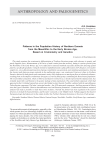Статьи журнала - Archaeology, Ethnology & Anthropology of Eurasia
Все статьи: 351

Oldowan or pebble-flake industry? Levantine Mousterian or Levantine middle Paleolithic?
Статья научная
The emergence of Levallois technique and the origin of the Levantine Middle Paleolithic, addressed in my previous publication, are revisited. In the fi nal Acheulean of the Levant, the Acheulo-Yabrudian industry emerged and the blade technology was invented. On that base, the Levantine Middle Paleolithic originated. The terms “Oldowan industry” and “Levantine Mousterian” should be abandoned. The Oldowan industry was associated with Homo habilis, who had never migrated outside Africa. Because early Middle Paleolithic industries originated from the Acheulo-Yabrudian industry of the Levant, they should be referred to as Middle Paleolithic rather than Mousterian. The Mousterian was associated with H. neanderthalensis, whereas the industries of territories where Neanderthals had not migrated should be referred to as Middle Paleolithic. Neanderthal migrations resulted in the emergence of Mousteroid industries in Eastern Europe, Caucasus, Crimea, southern Siberia, etc. In Africa, a new taxon Homo heidelbergensis (H. rhodesiensis) originated ca 800 ka BP. Eventually, those humans migrated to the Near East, as evidenced by the Gesher Benot Ya'aqov site. Throughout the Middle Pleistocene, Near Eastern, primarily Levantine populations were involved in the sapienization process. By the early Upper Pleistocene, two sister taxa had apparently originated there: anatomically modern humans (Skhul, Qafzeh) and Palestinian Neanderthals (Tabun, Amud, Kebara). There was no radical change in Acheulean or Middle Paleolithic industries in the Levant that might suggest immigration from Africa or the adjacent territories of Eurasia. Anatomically modern humans associated with the Nubian Levallois industry migrated from Africa to Arabia ca 110 ka ago. They may have had short-term contacts with Levantine Middle Paleolithic populations, but archaeological evidence of acculturation is lacking.
Бесплатно

On a distinctive feature of the Andronovo (Fedorovka) funerary rites in the Baraba forest-steppe
Статья
Бесплатно

On the date of the Great Shigir idol
Статья научная
The Great Shigir Idol is the largest anthropomorphic wooden sculpture in the world, a unique work of Stone Age art, and a valuable source for reconstructing the material culture and worldview of the ancient population of Northern Eurasia. Although study of it began more than 100 years ago, a number of issues, such as the place of discovery, context, date, methods of exhibition, etc., remain controversial. This article analyses archival documents relevant to the location and time of discovery of the Great Shigir Idol, and on the accompanying finds. The results of a recent comprehensive study conducted by Russian and German archaeologists and scientists in 2014 are outlined. The focus is on the analysis of AMS radiocarbon dates, spanning a period from the Late Pleistocene (~10,500 cal BC) to the Late Mesolithic/Early Neolithic (~6000 cal BC). These dates show a considerable range of variation, and they disagree with those derived from the conventional radiocarbon dating in 1997. Paleogeographic and archaeological data from the Trans-Urals do not support the early (9600–9000 cal BC) estimates of the time of the idol’s creation, but rather correspond to later ones, derived from the AMS 14C analysis conducted in 2014. Therefore, it is necessary to continue the study of Mesolithic sites and paleoclimate of the Urals, determine the nature of primary peat formation at the Ural peatlands, and assess their age and that of the microremains of peat in early cracks in the idol, etc.
Бесплатно

On the history of Asian Bosporus in the early Byzantine times: excavations at Verkhnegostagaevskoye
Статья
Бесплатно

On the time and context of the earliest bronze mirrors in the Northern Pontic region
Статья обзорная
Бесплатно

Peculiarities of using 2D electrical resistivity tomography in caves
Статья
The effi cienc y of archaeological studies inside caves could be greatly enhanced by geophysical methods because of their potential for examining deposit structure and features. Application of those methods in caves entails a number of problems caused by limited space for measurements and the complexity of the surrounding medium’s structure as compared to above-ground measurements. In 2017, Selungur Cave in the Fergana Valley, Kyrgyzstan, was examined using electrical resistivity tomography. Because of the above concerns, in the course of the work the question of the reliability of the results arose. To clarify the issue, a numerical experiment was performed to assess the effect of the three-dimensional cave geometry on the results of a two-dimensional inversion. It was found that variations of cave geometry parameters result in unexpected false anomalies, and considerable errors in bedrock location and resistivity can occur. In the case of downward diverging cave walls, an accurate resistivity section can be obtained by using the inversion based on a two-dimensional model. Therefore, electrical resistivity tomography in caves with similar geometry can yield reliable resu lts concerning the shape of bedrock surface, the thickness of sedimentary layers, and size and position of inclusions such as fallen fragments of roof therein.
Бесплатно















